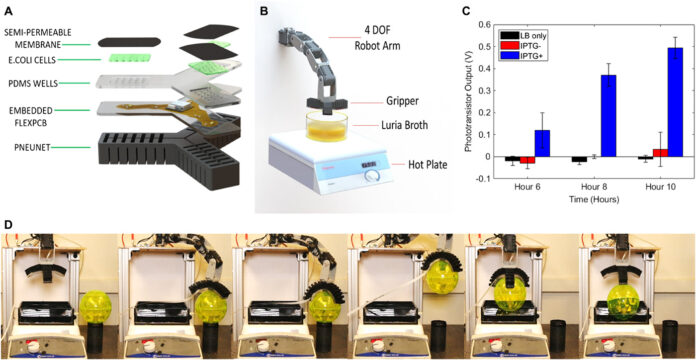UC Davis, Carnegie Mellon engineers bring together synthetic biology and soft robotics
Robots are often thought of as metallic, manufactured and artificial. Yet recent research conducted by engineers at both UC Davis and Carnegie Mellon University (CMU) has opened up a branch of science in which robots and nature collide.
Carmel Majidi, an associate professor of mechanical engineering and director of the Soft Machines Lab at CMU, expressed interest in the relationship between biology and machinery.
“I’ve always been interested in how natural organisms and biological materials
can inspire new types of machines and materials technologies,” Majidi said.
Cheemeng Tan, an associate professor in biomedical engineering at UC Davis, began collaborating with Majidi when he was a post-doctorate at CMU. They both wondered if combining synthetic bacteria with a soft robot could create a new function for the robot.
The term “soft robot” is due to the robot’s gripper function — the fingers are made soft in order to grab and adapt to the shape of the object, according to Tan. Majidi explained that these rubbery fingers are embedded with sensors composed of genetically modified E. coli bacteria that are able to create fluorescent proteins when in contact with a certain chemical and a flexible circuit. The fluorescence is then converted into an electrical signal that directs the robot’s fingers.
“We chose E. coli because of the versatility with which we can turn it into an artificial cell with properties that we can engineer,” Majidi said. “Through genetic modifications, we can ‘program’ the E. coli bacteria so that it responds to chemical stimulation in a way that we can measure with on-board electronics.”
Tan discussed two primary challenges that arose when designing the robot: creating an environment within the soft robot where the bacteria could function and engineering an interface where the bacteria could communicate with the robot. The solution was to house the bacteria in an artificial growth chamber and design a tube to detect the optical signal from the bacteria and instruct the robot.
“We had a challenge for awhile with the membrane system, but we didn’t know it for awhile,” said Phillip LeDuc, a professor of mechanical engineering, biomedical engineering, computational biology and biological sciences at CMU. “It was through patience and persistence that this was solved!”
Since the communication aspect of the robot was one of the most challenging parts of the design — because of how small the signal being detected was in comparison to the environment — it took two years to finetune this function. The original idea for this collaboration was conceived in 2013, and its first prototype was developed around three to four years later.
“The next steps are to literally design the robot so that it can start taking steps,” Majidi said. “The current robot is a gripper that is mounted to a robotic arm. The next robot would be like an octopus or starfish that could move around and collect chemical samples at different locations. Another future goal is to use advancements in synthetic biology to be able to measure a wider range of chemicals or environmental conditions.”
Majidi hopes that from their research people will realize it is indeed possible to combine synthetic biology and soft robots in the same material architecture. She believes that the continuation of this field of study could lead to the development of soft biohybrid robots that use artificial cells to achieve new adaptive functions.
“In terms of science, I’d like people to learn about how we could combine living cells and materials in a new way to create new hybrid systems that can do new things that existing organisms or existing materials cannot do,” Tan said. “In terms of just general approach, I’d like people to know more about interdisciplinary science and how one can work with people with different expertise and then combine the expertise to really create a new area.”
Written by: Michelle Wong — science@theaggie.org





